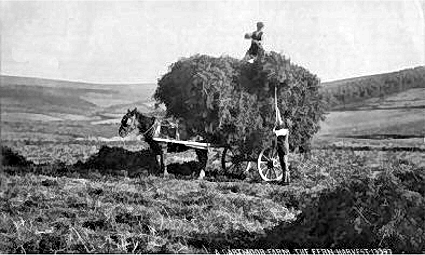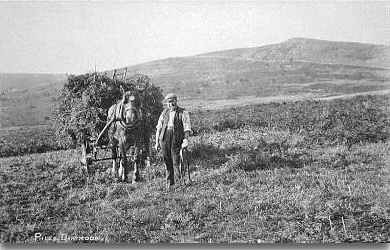
“He voiced his opinion on a day when he and Lawrence were working together on the great fern slopes under the Beacon. There, some weeks before, the bracken had been mown down with scythes, and now the harvest was dry and ready to be stacked for winter litter. They made bales of the fern and loaded up a haycart.” – Eden Phillpotts, Orphan Dinah, p.36.

Firstly it may be as well to explain some Dartmoor terminology in respect of the’Fern or Vern Harvest’, the words fern and vern are terms which encompass a variety of ferns found on Dartmoor and what concerns this page – bracken. In the case of the ‘Fern Harvest’ this referred to the annual cutting of bracken for agricultural purposes. For centuries this natural resource has been a valuable commodity for the Dartmoor farmers. The right to cut bracken on Dartmoor has been granted to both manorial tenants and commoners alike under the term of estover. The main purposes of this harvest was to provide winter bedding for the livestock and as well as being absorbent compared with other bedding types it kept the livestock warm, (an interesting modern-day bedding comparison can be found – HERE).. Once the shippens were cleaned out after winter the fern bedding would be utilised as a fertiliser. Another purpose the crop was used for was bedding down root crops such as potatoes and turnips in their underground clamps during winter. In 1915 the Board of Agriculture and Fisheries issued the following advice on bracken used as a fertiliser; “Bracken possesses a considerable power of absorbing ammonia and urine. To secure the full absorptive effect, however, bracken must be very thoroughly trampled upon by stock. Dung made from bracken may be expected to be equal in chemical composition to dung made from straw. On the other hand, it takes longer to decompose in the soil, the fibrous woody stem being only slowly attacked. It therefore opens up the soil more, and is for that reason likely to be more useful on a heavy clay than on a light sandy soil. Bracken should be cut and dried in autumn, but where this is impracticable it may be cut and carted during suitable weather throughout the summer months.” – The Western Times, September 28, 1915.
There can be no question that the Fern Harvest was labour intensive, due to the very rocky nature of the moor it meant that in most cases it was impossible to use mechanical harvesting means. This meant an arduous task of cutting the bracken by hand by means of a scythe. Once cut and allowed to dry and was then loaded onto a cart by using pitchforks and transported back to the farm when it would then be stored for future use. There were also instances of workers taking the cattle out to graze in the mornings and cutting a patch of bracken. Then when they fetched the animals back for afternoon milking the dried vern would be carried back in a net.

The Fern Harvest normally took place once the corn had been cut or after being harvested, this was then time for men to get busy scything their livestock’s winter ‘mattresses’. The following account of a bracken harvest appeared in the Western Evening Herald on August the 24th, 1924; “In some parts of Dartmoor I notice the farmers who cannot get on with other work, have set about cutting bracken for the winter. To the moorland farmer the dried bracken means a considerable saving. If he were not able to get the fern for bedding purposes, there would be a smart inroad made on what wheat and oat straw he may have, and that never runs to much. By harvesting the bracken he is able to save his straw for fodder for his cattle.
Cottagers are also busy getting in supplies which they use in fowl’s houses and for their pigs, and also for the protection of early potatoes against frost. As a garden manure, well-rotted bracken is very valuable, though it is not suited for all crops.” – Western Evening Herald.
Similarly in the Western Morning News of 1929; “Now that in many quarters on the fringe of the moor all the corn is cut, but not ready for carrying, the moor men are busy loading the bracken they mowed down with the scythe some time ago. High-piled wagons with their brown loads are something of a picture in a Dartmoor setting as they wend their way over the heather and through the furze, tossing this way and that, against the red of the western sky as nightfall comes on. The bracken harvest is seen at its best on Dartmoor. What the moor farmers would do without it as bedding for cows and horses in the winter is difficult to estimate. What straw is to others in more favoured quarters the bracken is to them, and has been for untold generations. In times of scarcity it has been known to be cut in its young growth, and after being beaten or chopped small fed to pigs with good results. But no creature cuts growing bracken.” – September 29th, 1929. The exact time of cutting the bracken was crucial with many manors stipulating the timing. In 1872 the manors of Dunstone and Blackslade stated; “We present that by custom of this manor no fern should be cut before September in the commons non the east side of the valley nor before the 10th September in those on the west side.” To give some idea of the quantities of fern harvested it was recorded that three men were cutting ferns over a period of a few weeks during which time they carted 16 loads back to the farms. Wood, pp.144 -145.
Should for whatever reason any of the bracken crop fail then it could mean disaster for the Dartmoor Farmer. In 1939 such a scenario occurred with respects to the bracken, so much so that the Dartmoor authoress Beatrice Chase wrote the following;
“Some curious distemper has attacked the bracken on Dartmoor this year. After careful enquiries among the oldest farmers I can find no one who has ever seen the like. The plants are only a foot to 18 inches high, brown and shrivelled, not the least like the ordinary decay, but having the air of having been watered with weedkiller. They have the burnt up, shrivelled look which phioxes get when attacked by stem canker. The disease whatever the thing is applies to many acres in such places as Hey Tor, Challacombe Headland, Soussons, Hamildown, Bonehill, Buckland Common and many others.. It appears to be healthy below a certain height as for instance around the Fingle Bridge district, and a certain height below Buckland Beacon, near the woods. It is a new light to everyone here that any weather or other conditions can affect bracken, and we would be grateful if any savant (learned person) could explain it. The crop is so badly affected that there will be no bracken harvest next month in many of the usual places, and it is rather important to know if it is a disease and likely to spread to other plants and growths such as roots. Bracken is used all over the Moor for bedding cattle all the winter, for bedding down root for winter, and also in manure. I have reported to the Ministry of Agriculture.” – The Western Morning News, August 29th, 1939. One possibility of this disease may have been a parasitic fungicide known as corticium anceps which causes stunted growth and rapid shrivelling?
Today bracken is viewed in many quarters as a problem due to its rapid expansion which now covers large areas of Dartmoor. It’s also responsible for damaging many of the archaeological features on the Moor as well as harbouring ticks which are a danger to both livestock and humans. The ironic fact is that the plant could still be a cheap source of bedding for livestock owners if it wasn’t so labour intensive to harvest. In 2017 the adverse weather conditions meant lower than normal wheat and barley straw crops. In addition the very wet conditions at the beginning of 2018 meant livestock were housed longer than normal. These two factors combined meant that there was a massive shortage of straw coupled with a huge spike in demand, the results being that the price of straw rocketed. In the February of 2018 the average price of a tonne of wheat had increased by 62% and barley straw by 73% compared with 2017, either way it was a hard financial hit for many farmers. At that time I wonder how many Dartmoor livestock farmers looked to the russet bracken infested moorland and were taken back to the practices of their forefathers? I also ponder the question as to how many were tempted to look into the practicalities of reviving the custom of the Fern Harvest? I know the latest advice is that bracken spores “may cause bladder lesions or carcinomas in cattle and can lead to blindness in sheep,” but also, “the toxicity of bracken varies with plant growth stage, being highest in young leafy material and lowest at the optimum cutting stage in the autumn. ” Even so for a one-off emergency measure would the risks be worth it?
There is however one Westcountry firm that is commercially utilising bracken called Brackenburn who are located in Weston-Super-Mare. They harvest bracken and turn it into ‘brackettes’ for the purpose of burning on open fire or log burners. They claim that the brackettes burn hotter and longer than oak plus the ash provides a source of potash fertiliser.

Woods, S. 2003. The Dartmoor Farm. Tiverton: Halsgrove Publishing.
 Legendary Dartmoor The many aspects past and present of Dartmoor
Legendary Dartmoor The many aspects past and present of Dartmoor

This is really fascinating.
Did the harvesting practise due out because of the scare of the spores causing cancer?
It could well be, the latest advice from Eblex is; “The evidence suggests that bracken should be avoided if possible due to the animal health
problems identified on farms that have used bracken as bedding a lot in the past.”
Bracken spores and cancer. Wishful thinking, or nonsense.